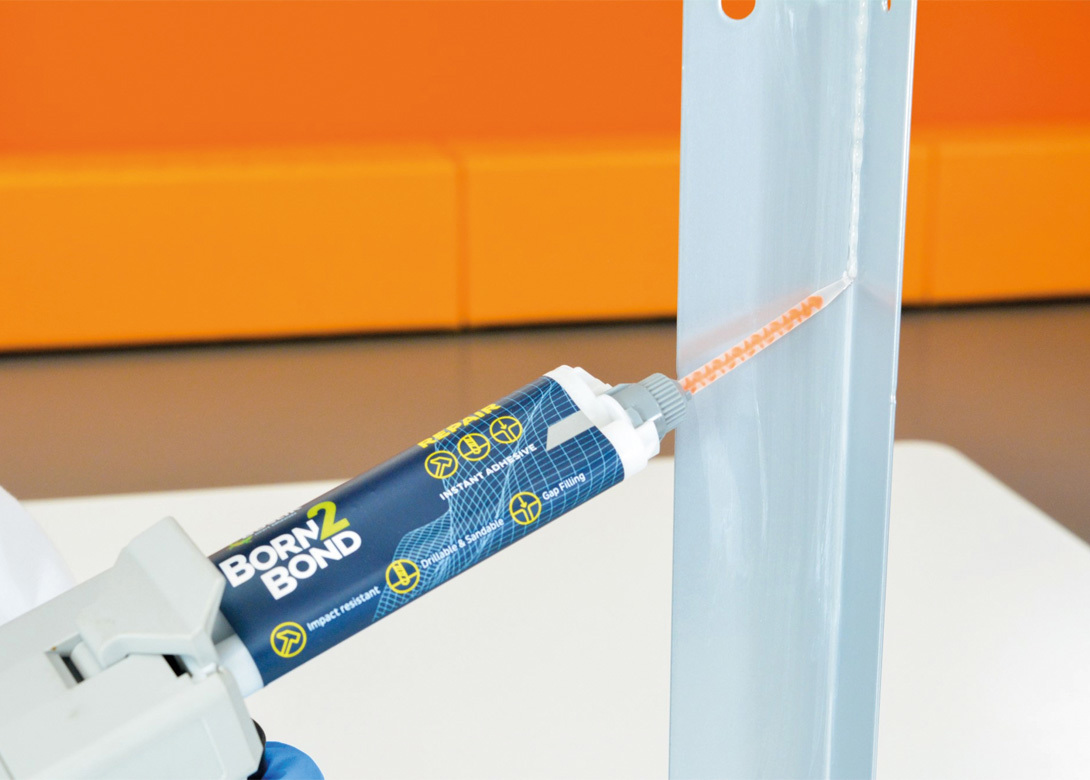

Here Paul Whitehead, strategic accounts manager at Intertronics, focuses on the capabilities of cyanoacrylate adhesives and looks to dispel some of the myths associated with their use in applications.
Cyanoacrylate adhesives (CAs), also known as instant adhesives, or superglues, are fast curing
adhesives, suitable for bonding a wide variety of substrates, including metals, plastics, elastomers and porous materials.
At the molecular level, cyanoacrylates are composed of acrylic monomers stabilised by a weak acid. Cure is initiated when the acidic stabiliser is neutralised by a weak base, typically water, resulting in polymerisation into a long chain polymer. CAs can be based on various monomers but are most commonly formed from ethyl cyanoacrylate (ECA) or methoxyethyl cyanoacrylate (MECA) monomers.
Myth one: All CAs are the same
While it is possible to walk into your local hardware store and purchase a consumer CA, these are not indicative of the capabilities of all CA materials. Newer entries to the market aimed at industrial and technical use have been formulated to overcome some of the adhesives’ historic challenges and broaden the applications for which CAs are used.
Cyanoacrylates are produced in a variety of formulations, each exhibiting distinctive attributes of viscosity, thixotropy, cure time, bond strength and more. There are materials available for everything from hobbyist woodworkers, and electronics manufacturing, to medical-grade skin bonding materials for wound closure.
Myth two: CAs are brittle
While CAs are generically brittle, some, like the Born2Bond™ Ultra range, are less brittle than conventional products. Rubber-toughened formulations can offer better impact resistance. Adhere ADH9480 cyanoacrylate adhesive, for example, when compared with other grades, offers improved shock resistance and peel strength, and has a longer setting time than other grades – while being specially formulated to achieve the strongest possible bond between well-mated non-porous surfaces. Alternatively, ADH9105 offers higher impact, humidity and temperature resistance than similar materials, resulting in a more flexible bond.
Recent innovations have seen the launch of CAs that are inherently flexible. For example, Born2Bond™ Flex offers >200% elongation, absorbs impact and vibration, and copes with bonding substrates with different thermal expansion coefficients.
Myth three: CAs have a maximum operating temperature of 80⁰C
While 80⁰C is the maximum recommended operating temperature for a lot of CAs, there are several products available that offer improved temperature resistance. Born2Bond™ Structural, for example, can withstand temperatures up to 120⁰C, while ADH9480 can handle heat up to 125⁰C.
Myth four: CAs always cause blooming
A side effect of CA volatility, blooming is the name given to the chalky-white residue that appears on the surface of the part. While it does not affect bond integrity, blooming can be aesthetically undesirable. Because CAs based on MECA monomers are less volatile than ECA products, they are less susceptible to blooming. Manufacturers looking for a low bloom material could consider ADH9408, ADH9640 or ADH9403.
Recent advances have seen the introduction of low blooming MECA materials with fewer compromises, for example Born2Bond™ Light Lock, which has an additional light curing mechanism, or Born2Bond™ Ultra, which combines the fast curing associated with ECA-based CAs with the low blooming characteristics of MECA-based products.
Myth five: CAs have an unpleasant odour
Almost anyone who has used superglue at home will have noticed its distinct smell. When working with traditional CAs, it is important to work in a well ventilated area and with the correct protective equipment. A suitable dispensing methodology can reduce the need for handling and improve health and safety.
However, not all CAs smell and low bloom formulations are also low odour. Born2Bond™ Ultra, for example, has inherently low volatility, which means less odour, less irritation and no CLP hazard symbols on the label.
Myth six: CAs must be dispensed manually
There is no requirement to apply a CA directly from the tube or bottle. Depending on the level of accuracy and repeatability required, as well as the throughput of the application, CAs can be dispensed as part of a manual, semi-automated or fully automated process.
For example, a pressure pot, or reservoir, can be combined with a suitable diaphragm dispensing valve for a semi-automated, precise dispensing technique. Mounting this equipment onto a robot to automate fully will result in a methodology that requires very little operator intervention. The trick to establishing a successful dispensing methodology is finding an adhesive supplier that is also experienced with the relevant dispensing and automation equipment.
Myth seven: CAs aren’t gap filling
Most cyanoacrylate adhesives are inherently of a low, runny viscosity, which means they don’t work well when there are gaps to be filled; if the parts are porous; or if the bond-line orientation means that the adhesive would drip or run. However, CAs are now available in a range of different viscosities for gap filling. Born2Bond™ Repair, Structural, Flex, and Ultra, all offer high viscosity formulations for gap filling. The high viscosity ADH9454 CA gel, for example, prevents running on inclined or vertical surfaces during its 3 to 60 second fixture time, which enables gap filling up to 0.5mm, as well as minimising
the absorption of adhesive into porous substrates to ensure a good bond.
Myth eight: CAs have poor moisture and solvent resistance
This is generally true and, in the past, this has limited CA use in many industrial applications. However, CAs actually have better resistance to non-polar solvents like IPA; it doesn’t seem logical, but cyanoacrylate adhesives also have more chemical resistance to petrol than they do to water. Advances like the hybrid chemistry of Born2Bond™ Structural now give superior moisture resistance, showing a very small reduction in adhesive strength after 1,000 hours immersed in water, and much improved compatibility with polar solvents.
Myth nine: CAs are not structural adhesives
To date, CA bond strength has been readily compromised by temperature and moisture/humidity, which has limited their use for load bearing applications. However, Born2Bond™ Structural has very high impact resistance (27 KJ/m2 steel after 24 hours), and toughness. It develops structural bonding performance to steel, ABS, PVC, phenolic and polycarbonate, amongst other substrates, and features particularly good adhesion to aluminium (lap shear strength 12 MPa). With higher temperature, moisture and solvent resistance, it is a good candidate to test for a structural industrial application.
Myth ten: CAs stick your fingers together, forever!
More people than would care to admit have accidentally stuck their fingers together with Super Glue – the moisture in our skin is ideal to initiate curing. Luckily, soaking your hands in soap and warm water will loosen the cyanoacrylate enough for you to slowly peel your fingers apart. If this doesn’t work, an acetone-based nail varnish remover should finish the job. If CA on the skin were left untreated, the fats and oils in your skin would eventually remove the glue and unstick your fingers, though it’s not recommended to test this out.

Will joined Fastener + Fixing Magazine in 2007 and over the last 12 years has experienced every facet of the fastener sector – interviewing key figures within the industry and visiting leading companies and exhibitions around the globe. Will manages the content strategy across all platforms and is the guardian for the high editorial standards that the brand is renowned.





